Cooking Kung Pao chicken is easy! This recipe shows you how it’s prepared the authentic way. Tips on sauce ratio, stir-fry techniques, substitute ideas & a tutorial video are included.
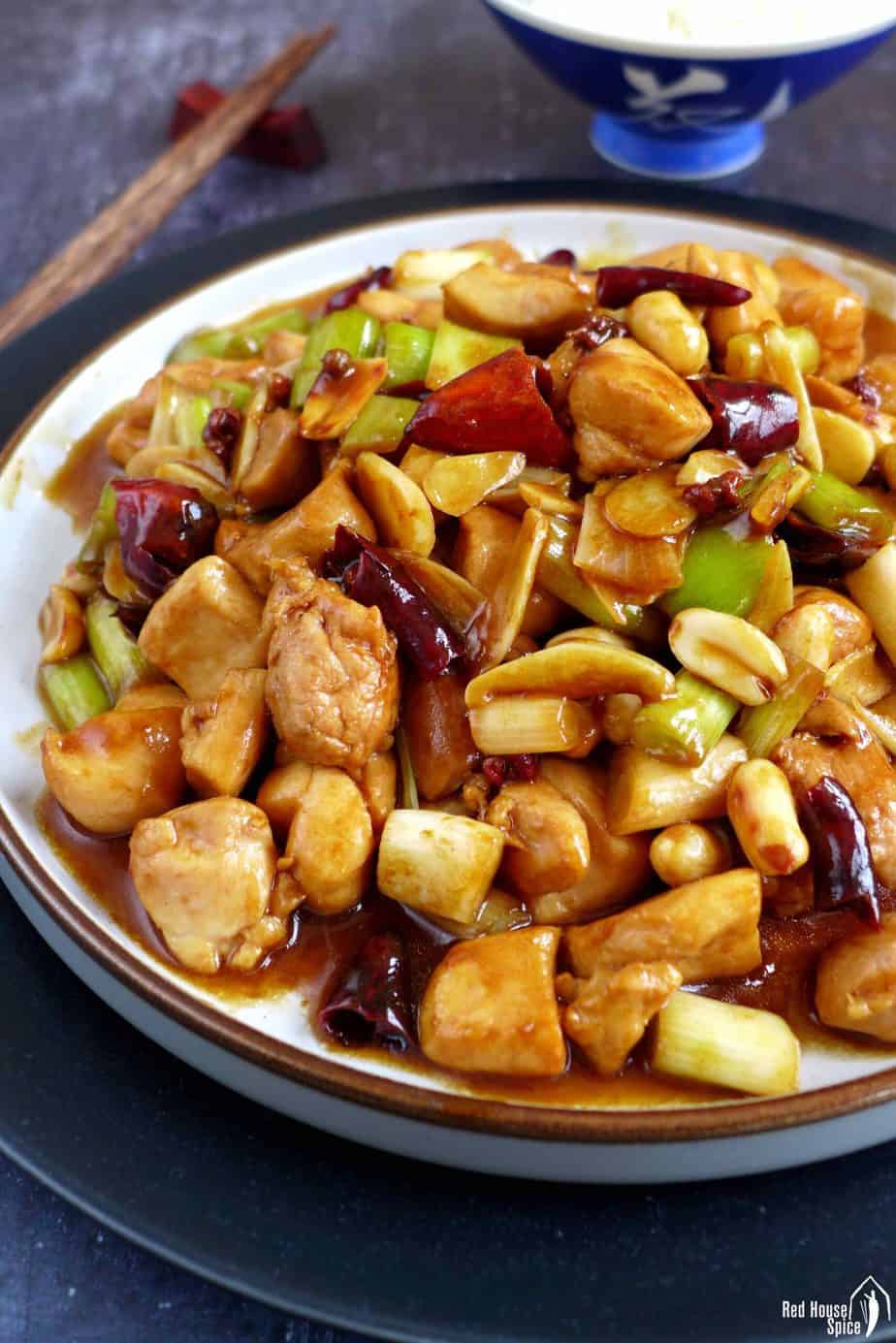
Jump to:
What is Kung Pao chicken
One of the most famous Chinese dishes, Kung Pao chicken/宫保鸡丁 is getting increasingly popular in restaurants (and take-away/take-out) outside China. I’ve seen and tasted some produced with all kinds of adaptations.
I’d like to share my recipe which is based on the traditional Sichuan formula. It’s inspired by conversations with professional chefs, cooking classes on my Culinary Tours of China, as well as by cookbooks on Sichuan cuisine.
Kung Pao Chicken (also transcribed as Gong Bao or Kung Po) originates from Sichuan province, China. It’s believed to be named after Ding Baozhen/丁宝桢, a governor of Sichuan in late Qing Dynasty whose private chef invented this dish. Consisting of cubes of chicken, chunks of scallions & peanuts, it’s seasoned with dried chilli, Sichuan pepper and a tasty sauce.
The cooking procedure
It takes 4 simple steps to cook Kung Pao chicken. Here is a summary of what to expect in each step:
- Marinate the chicken. Cut the chicken into bite-size cubes then mix with cornstarch, water and sesame oil.
- Toast the peanuts (or cashew nuts) in a pan until lightly brown.
- Mix the sauce with the following ingredients: light soy sauce, dark soy sauce, black rice vinegar, Shaoxing rice wine, sugar, cornstarch & water.
- Stir fry the dish by adding the ingredients to the wok in the following sequence: ① Oil, dried chilli & Sichuan pepper; ② Marinated chicken; ③ Scallions, garlic & ginger; ④ The sauce; ⑤ Toasted nuts.
How to prepare the chicken
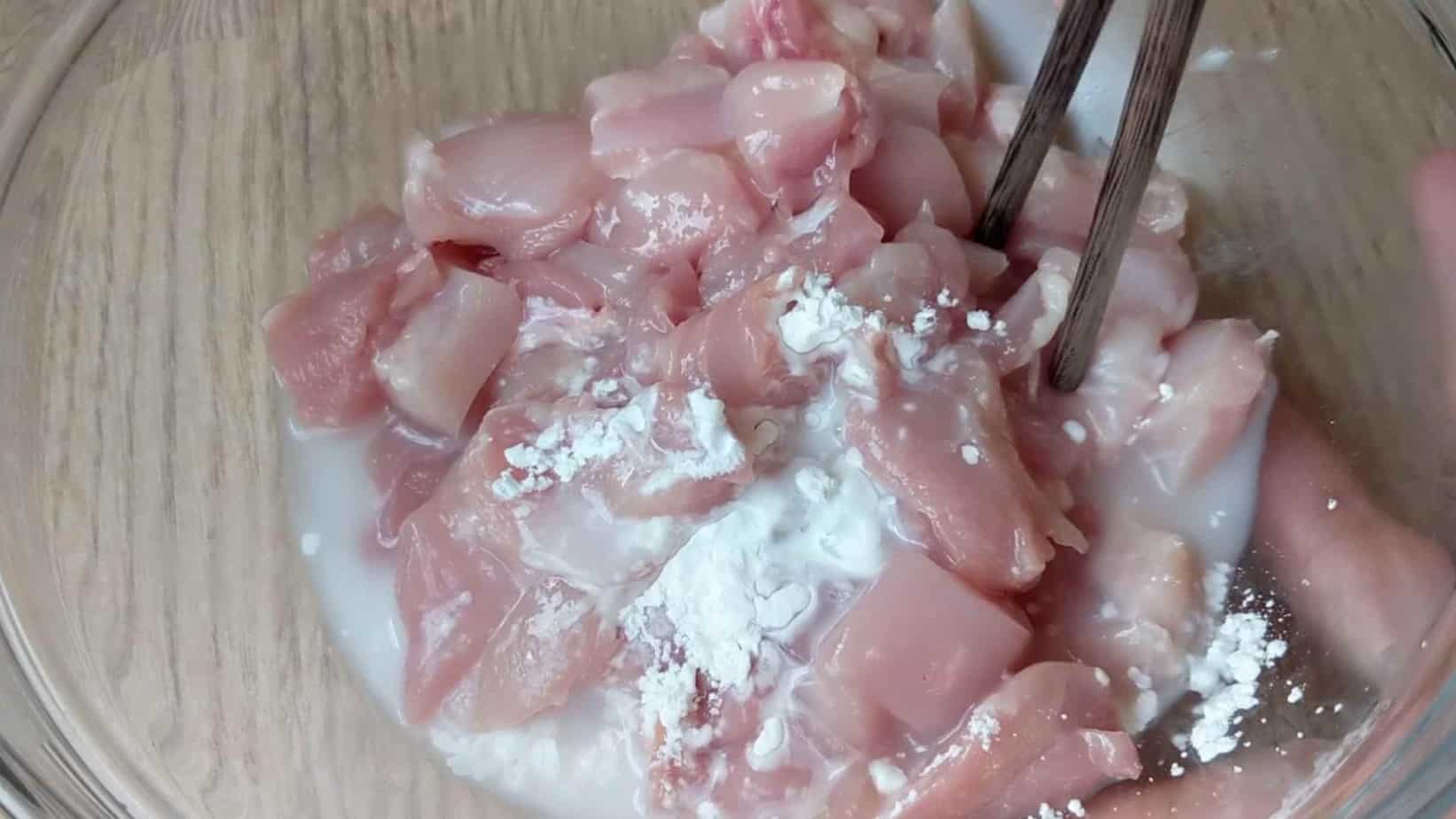
If you’re new to making meat-based stir-fry dishes, chicken is a great ingredient to start with. It retains its tender and moist texture pretty well during stir-frying if prepared with a simple marinade beforehand. Also, you don’t need to cut it into thin strips or slices. Cubes of chicken can be easily cooked through in a quick stir-fry.
Personally, I prefer chicken thighs for Kung Pao chicken, or other stir-fry dishes alike (eg. Black Pepper Chicken). It’s a flavoursome cut that contains a moderate amount of fat. Buy boneless, skinless thighs if possible. Trim off any excess fat if you wish.
That said, please feel free to use chicken breast. Marinate & stir-fry the same way. Be attentive not to overcook as chicken breast tends to have a drier texture than chicken thigh. So the timing is more crucial.
Ingredients for flavoring
Now let’s talk about other ingredients that make Kung Pao chicken distinctly different from other chicken dishes. Consisting of common Chinese condiments, spices and nuts, they create a sophisticated and addictive flavour: savoury, umami, sour, sweet, spicy, mouth-numbing, smoky & nutty.
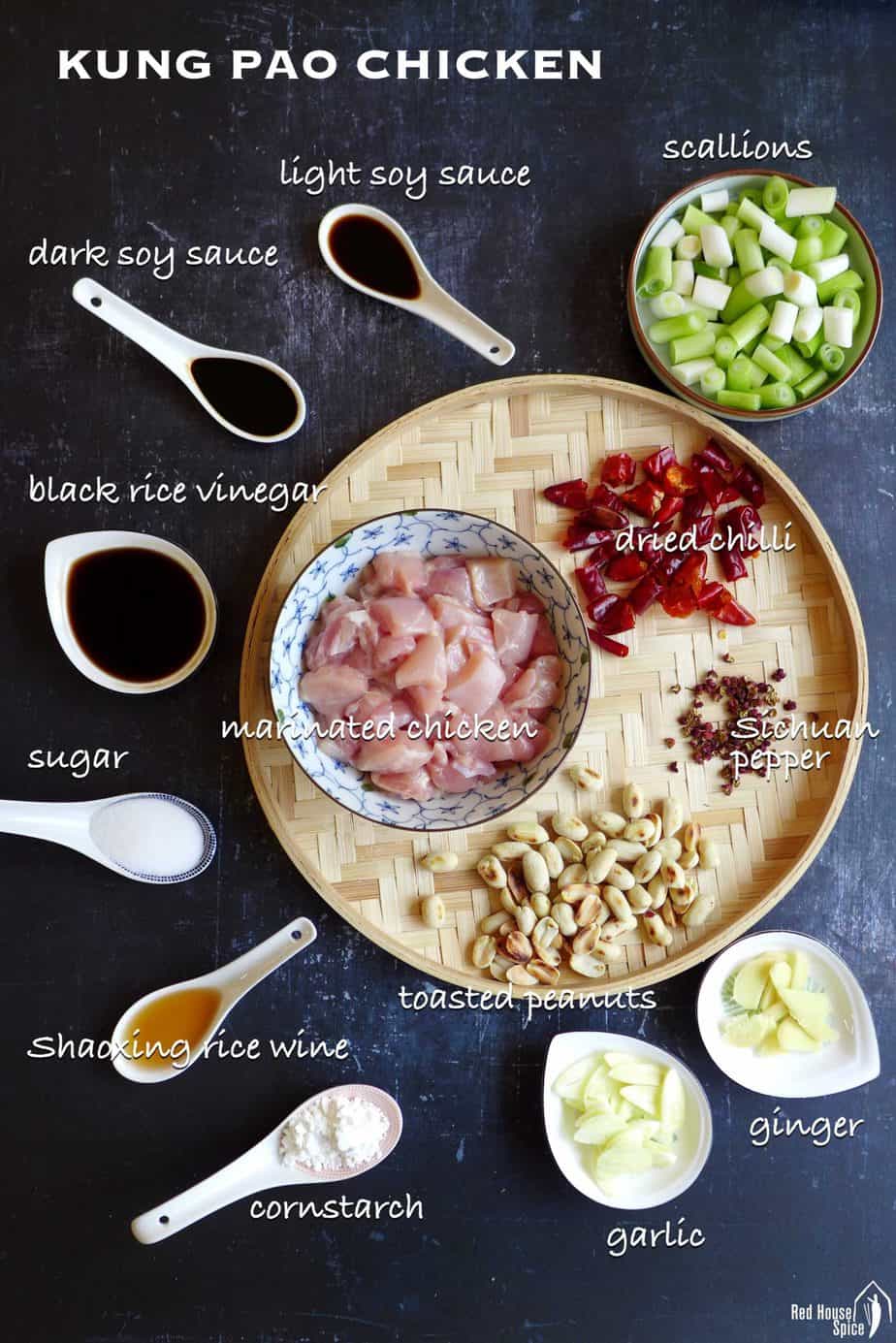
To produce the delicious “Kung Pao flavour”, each ingredient should show off its merit but not so strong that it overpowers other tastes. Let me list them and explain how they contribute to the dish.
Spices
Dried chilli & whole Sichuan pepper are used to create hot and numbing flavour. Also, they add a hint of smokiness if fried properly (More on this in later sections).
Scallions, ginger & garlic
Indispensable in Chinese kitchens, these three ingredients are used generously in Kung Pao chicken. Scallions, in particular, are essential if you wish to make the dish authentic. Use the stem part only and chop them in chunks to match the chicken pieces (the leftover part can be used to cook Scallion Pancakes).
Seasonings
It’s very important to get the seasonings balanced. Through tests, I’ve come up with the following ratio which I think is perfect in taste. For making 2 servings, you’ll need:
- 1 teaspoon light soy sauce
- 1 teaspoon dark soy sauce
- 1.5 tablespoon black rice vinegar
- 1 teaspoon Shaoxing rice wine
- 2 teaspoon sugar
- 2 teaspoon cornstarch
- 1 tablespoon water
If this is your first time making Kung Pao chicken, I highly recommend you follow this formula and measure precisely to get a ‘test taste’. Then please feel free to adjust based on your own preferences.
Nuts
Authentic Kung Pao chicken also calls for peanuts (toasted or deep-fried) which adds another layer of flavour. You may replace them with cashew nuts. It’s important that you add the nuts at the very end of the stir-frying process. Otherwise, they would lose their crunchiness.
About chili and Sichuan pepper
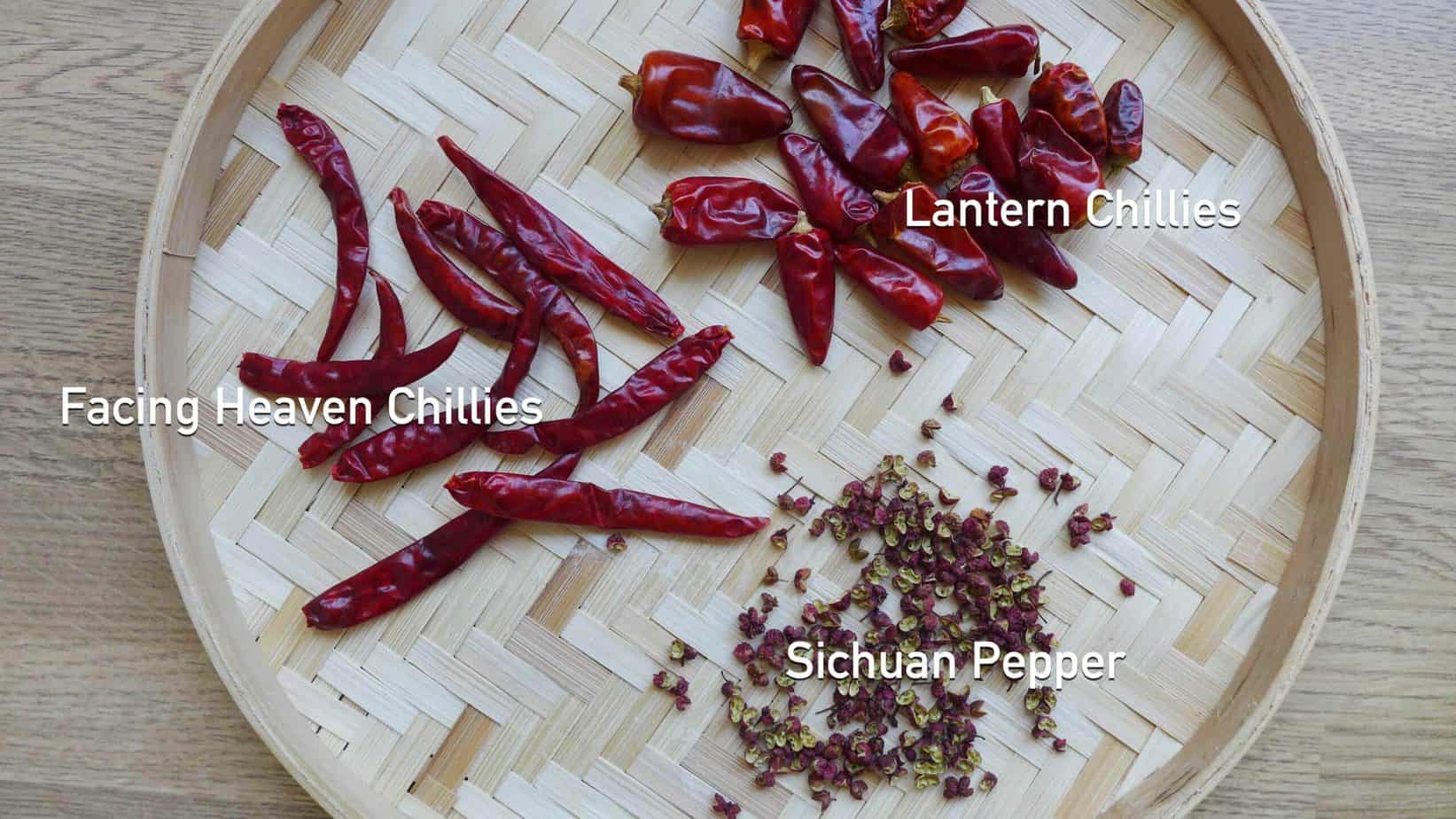
Being a classic Sichuan dish, dried chilli and Sichuan pepper can not be omitted when cooking genuine Kung Pao chicken. Paired with each other, they create the iconic Sichuan flavour known as Mala/麻辣 which means numbing & hot.
However, the tanginess of Kung Pao chicken is not as high as other mala classics, such as Sichuan Boiled Beef or Chongqing Mala Chicken, etc. People with mild tolerance to spicy food would also enjoy it (that’s one of the reasons why it has become popular worldwide).
I usually use a combination of two types of dried chillies (see image above): Facing Heaven chillies (Chao Tian Jiao/朝天椒) which has a high spiciness and Lantern chillies (Deng Long Jiao/灯笼椒) which only has a hint of spiciness but are rather aromatic.
Please feel free to use any types of dried chillies that suits your hotness tolerance and are easily available to you. The key point is to choose the fresh-looking ones: vibrant and shiny in colour. I find chillies of Indian origin work very well.
Regarding Sichuan pepper, please check out my ultimate guide to Sichuan Pepper, which provides information on all aspects of this unique Chinese spice. A purchasing guide is included.
How to Stir-fry
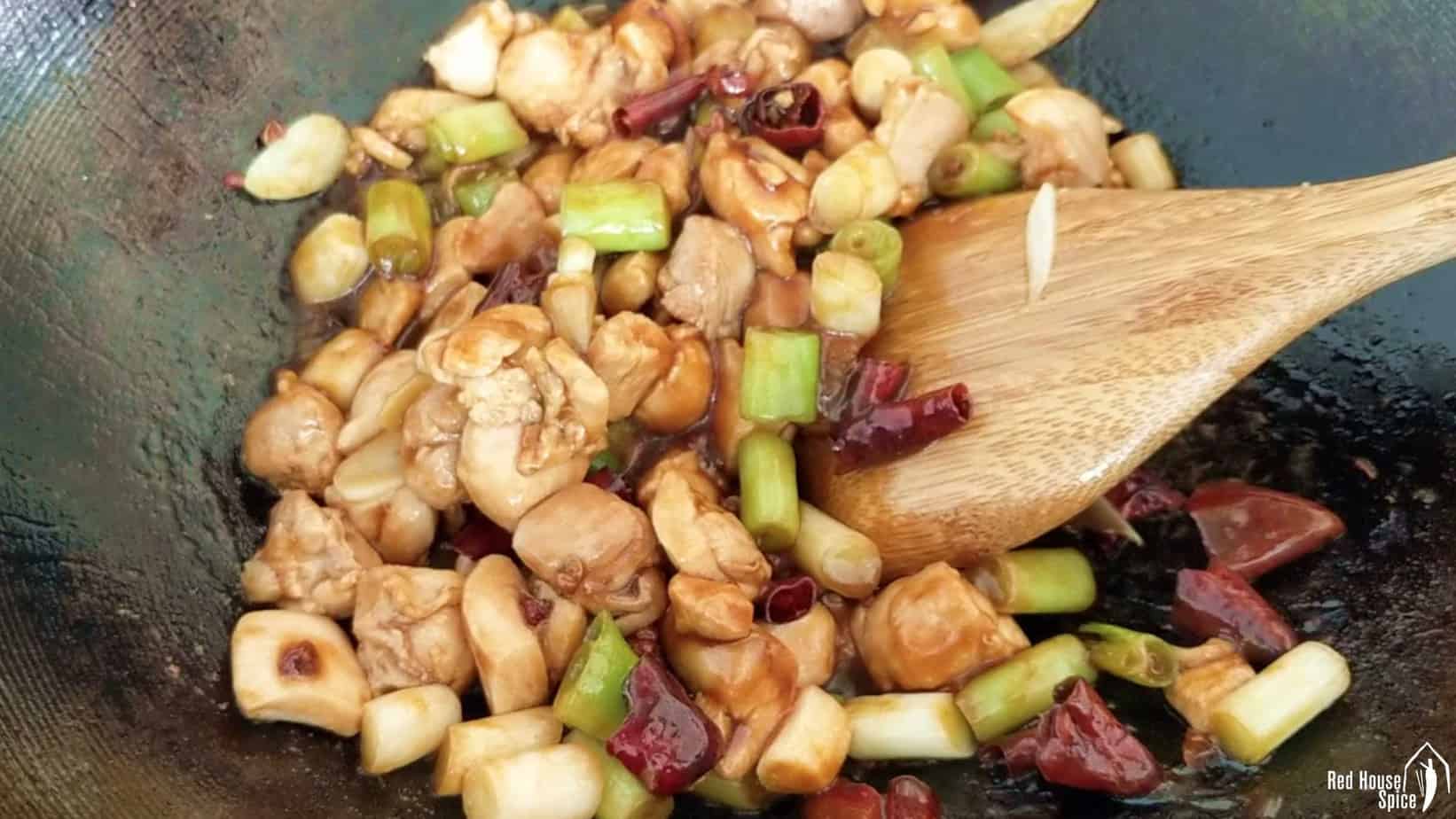
Timing is crucial when making stir-fry dishes if you are after the perfect look & taste. Here are some tips on each step that you might find helpful:
- Set your wok over high heat and fry dried chillies & Sichuan pepper in oil first. Keep a close eye to avoid burning. As soon as you sense the fragrance of the spices, add the marinated chicken. At this point, the chillies should still look red. They will darken later on and produce a hint of smokiness. If they look dark already at this stage, you are likely to burn them in the end.
- Fry the chicken pieces for about 30 seconds, then add scallions, garlic & ginger. Make sure you stir constantly to evenly heat the ingredients. When the chicken completely loses its pinkness, they should be cooked. Use the spatula to cut a piece to check if you’re not certain.
- Pour in the sauce (Give it a good stir beforehand). It will thicken pretty quickly (in about 20 seconds). Turn off the heat immediately.
- The last thing is to add the toasted peanuts (or cashew nuts). Stir to evenly distribute then dish out to serve.
Recipe FAQs
A: Yes. Like how I cook Kung Pao Shrimp, other proteins, such as beef, pork, fish, scallop or tofu, would work too.
A: Yes, you can. However, a traditional carbon steel wok does produce a more authentic taste.
A: Yes, please feel free to do so. The traditional recipe doesn’t call for vegetables other than scallions. However, increasingly restaurants (particularly the ones outside China) tend to add veggies, such as cucumber, bell pepper, onion, celery, etc.
A: Not really. Chinese black rice vinegar has a unique taste which is very different from balsamic vinegar. Shaoxing rice wine is a type of cooking alcohol which has no similarity to vinegar.
A: Yes. Tofu is a good alternative to chicken. Use the same pan-frying method found in my recipe for Garlic Sauce Tofu. You can also use King oyster mushroom as a substitute.
A: No. They are for flavoring the main ingredients in the dish.
Other chicken dishes
Looking for more chicken recipes? Have a look at these popular ones?
📋 Recipe
Love this recipe? Please leave a 5-star 🌟🌟🌟🌟🌟 rating in the recipe card below & if you REALLY like it, consider leaving a comment as well!
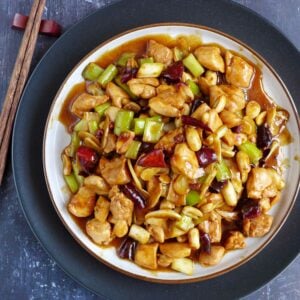
Kung Pao Chicken, the Authentic Way (宫保鸡丁)
Ingredients
For the chicken
- 11 oz boneless & skinless chicken thighs - or chicken breast
- 1 teaspoon cornstarch
- 1 tablespoon water
- 1 teaspoon sesame oil
For the nuts
- ⅓ cup peanuts - or cashew nuts
For the sauce
- 1 teaspoon light soy sauce
- 1 teaspoon dark soy sauce
- 1½ tablespoon black rice vinegar
- 1 teaspoon Shaoxing rice wine
- 2 teaspoon sugar
- 2 teaspoon cornstarch
- 1 tablespoon water
For stir-frying
- 2 tablespoon neutral cooking oil
- 10 dried chillies - halved and deseeded
- 1 teaspoon whole Sichuan peppercorn - see note
- 6 stalks scallions - cut into chunks
- 3 cloves garlic - sliced
- 8 slices ginger
Instructions
Marinate the chicken
- Cut the chicken into small cubes (about 2cm) then put into a bowl.
- Add cornstarch and water. Mix until no more liquid can be seen.
- Add sesame oil. Stir to coat the chicken evenly. Set aside.
Toast the nuts
- Put peanuts (or cashew nuts) into a pan. Toast over low heat. Stir from time to time to evenly heat the nuts.
- Remove from the heat when lightly brown. Transfer to a plate to cool.
Mix the sauce
- Add all the ingredients for the sauce to a bowl. Mix well then set aside.
Stir-fry the dish
- Heat a wok over high heat. Pour in oil then add dried chillies and Sichuan pepper.
- As soon as you smell the fragrance from the spices, put in the marinated chicken. Stir fry for 30 seconds.
- Add scallions, garlic & ginger. Continue frying until the chicken completely loses its pink colour (Do not overcook. You can test its done by cutting one piece open with the spatular).
- Give the sauce a good stir then pour into the wok. Stir to evenly coat the chicken. Turn off the heat as soon as the sauce thickens.
- Stir in the toasted peanuts. Dish out then serve immediately with plain rice.
Video
NOTES
NUTRITION
NUTRITION DISCLOSURE: Nutritional information on this website is provided as a courtesy to readers. It should be considered estimates. Please use your own brand nutritional values or your preferred nutrition calculator to double check against our estimates.


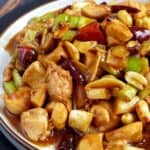
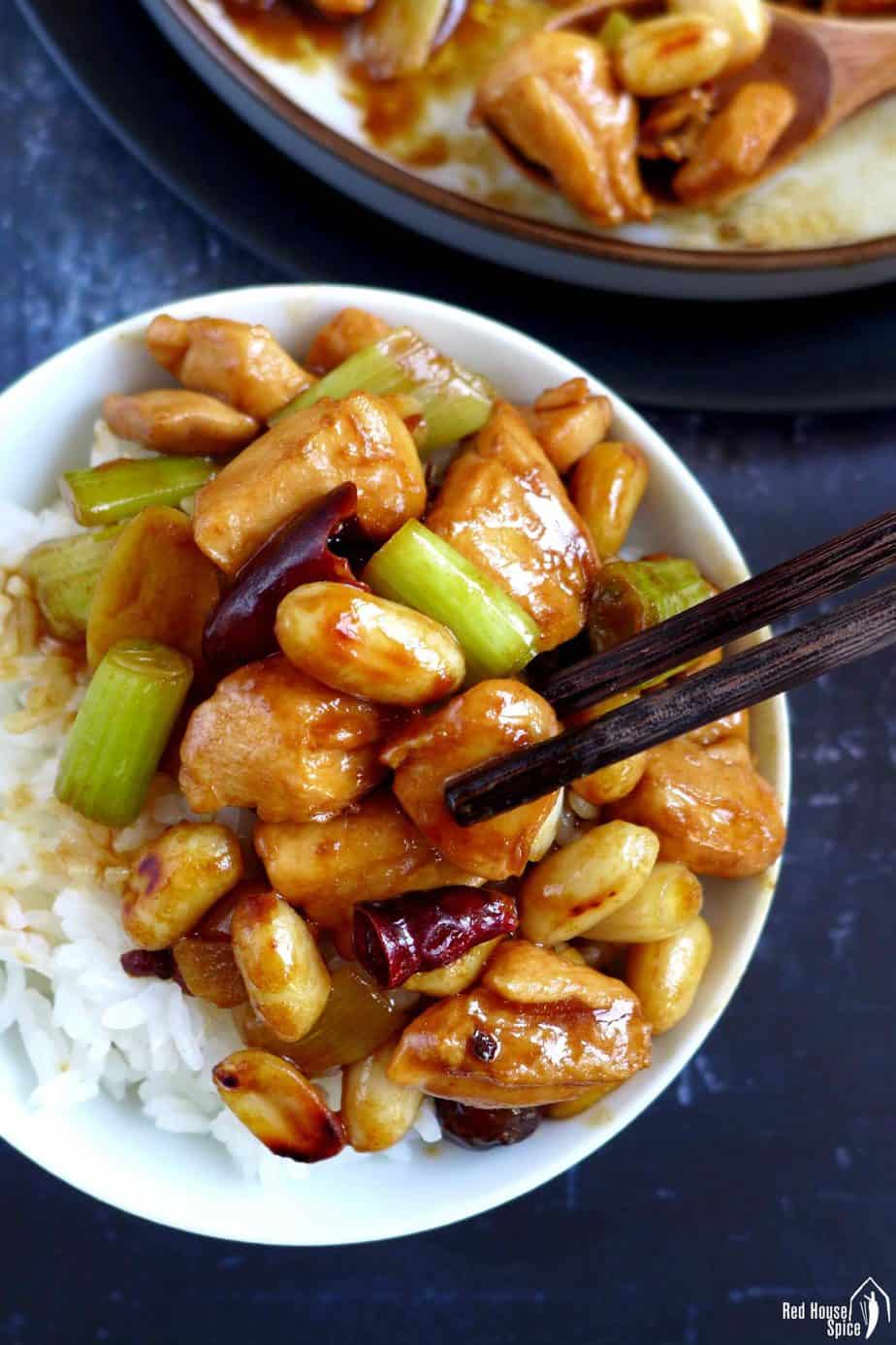
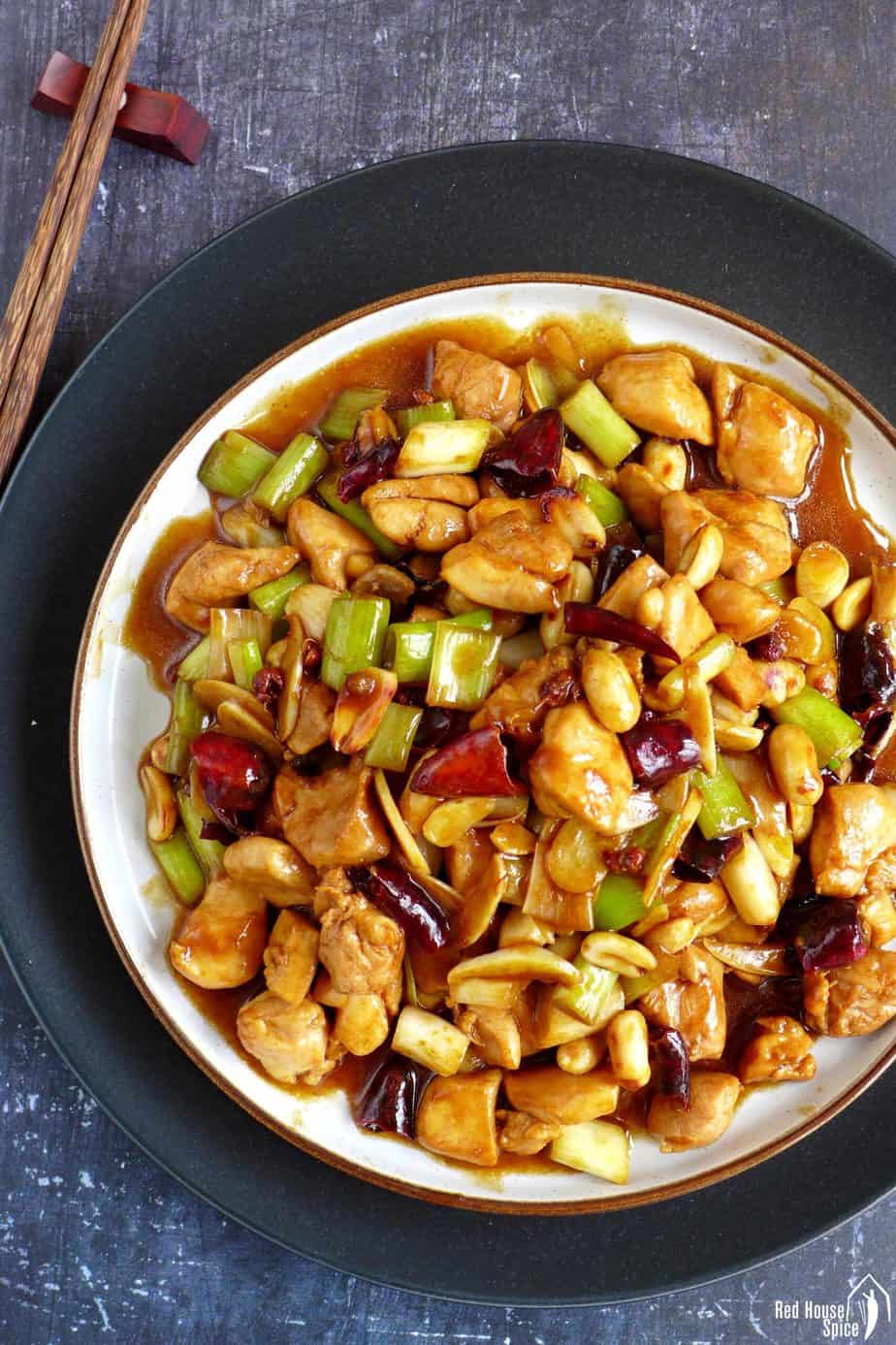
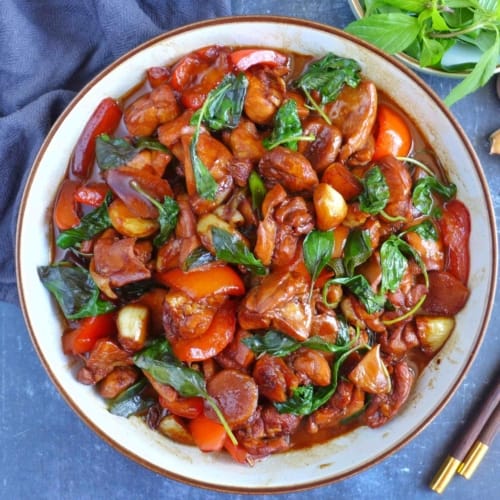
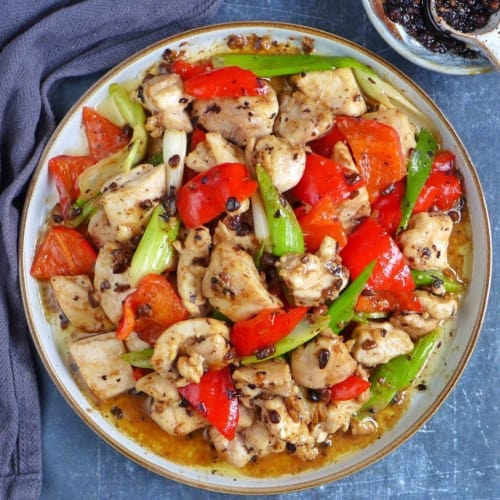
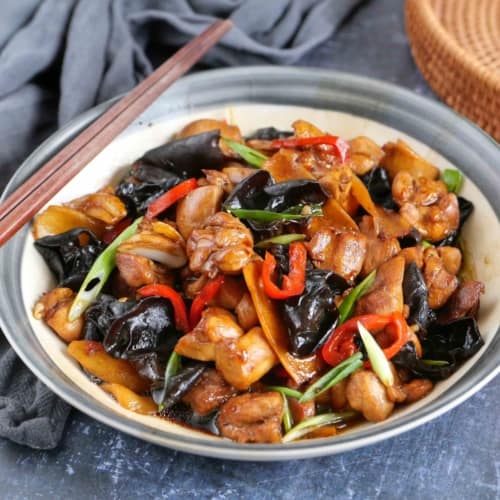
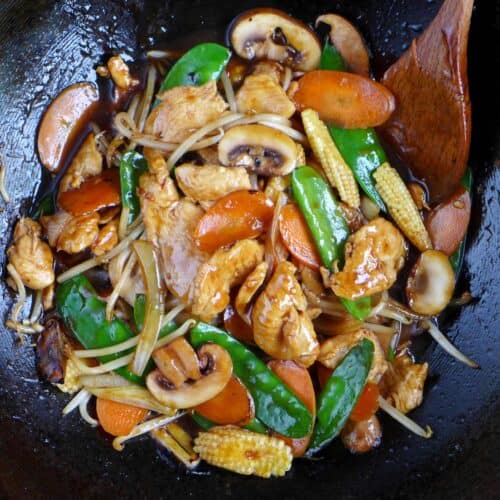

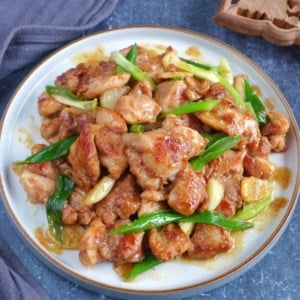
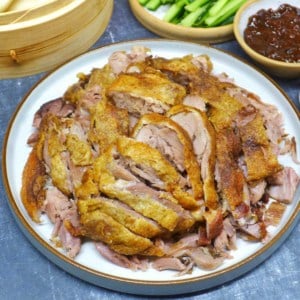
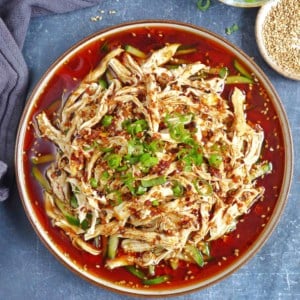
Very good! Just FYI, if you want something extremely spicy, go with all 10 dried chillies. If you are unsure, I would start with just 1!
Thank you! I will let you know how it turns out when I have a chance to make it.
Hello,
I tried the recipe today. Sadly, it did not turn out well. There was far too much vinegar for my taste and those peppercorns really ruin the dish if you bite into them. I know you’re not supposed to, but they are hard to avoid. If I make this again I’m going to remove the peppercorns after frying them and just use what they leech out into the cooking oil. What I ended up doing to salvage the dish was to double up on the sauce, but the second time I omitted the black vinegar entirely. Sometimes cooking doesn’t always work out, it is frustrating after all that hard work but that’s how we learn I guess. Regardless, thank you for the recipe even if it didn’t turn out the way I wanted it to. I tried something that was out of my comfort zone, even if it didn’t turn out the way I wanted I still learned something.
Sorry to hear that you didn’t enjoy the dish. I totally understand that everyone has different taste preferences. What I’m trying to do is to share recipes of classic Chinese dishes that are closest to their original flavor profiles. I hope you’ll find other recipes on my blog that inspire you.
Hello,
Thanks for the recipe, it looks quite good! I do have a question though: is it necessary to salt the chicken separately or is the salt in the sauce sufficient? Normally, when I prepare beef, chicken etc I salt it overnight ideally or a few hours before cooking so it absorbs the salt and then cook with it in any dish.
Hi Chris! There is no need to salt the chicken for this recipe as it’s cut into small pieces and the seasoning is sufficient to flavor it during stir-frying process. Happy cooking!
This was pretty spot on! Generally I’ve added chopped onion and bell peppers for color! Thank you for the sauce ratios. Little hack: If anyone has extra soy sauce sesame packets from the Trader Joe’s Knife Cut Squiggly (daoxiao) noodles, use that if you’re in a pinch :). Or if you have soy sauce packets lying around…..
That’s great to hear Susie! Glad you liked the sauce combination.
black rice vinegar?
Yes Gary, this recipe calls for black rice vinegar which adds an aromatic and tangy taste.
Oh yeh I like that ma la flavor. Sometimes I ma la orange chicken and if you like this try Mala chicken (Chongqing Laziji, 辣子鸡). Its really an acquired taste and you can ease into it by just sprinkling the ground szechuan pepper over chiffonade cut green onions then use it as a condiment if youre unsure or easing into the ma la flavor life style choice.
Your sauce is spot on. Last time i tried a different recipe and it was off on the ratios. I’ve used several of your recipes and they always turn out great.
That’s wonderful to hear Rose! Hope you’ll find more inspiration on my blog.